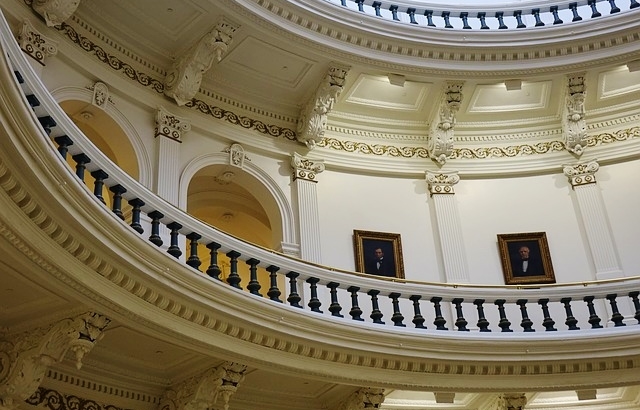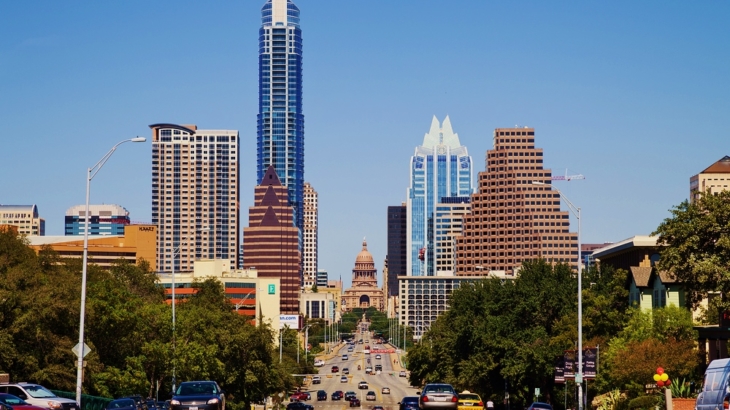LISTEN ON SOUNDCLOUD:
State capitol buildings in the United States embody the constitutional commitments found within the text of each state constitution, buildings that some have called the very temples of democracy. Each state capitol building in the United States presents the basic, fundamental attentiveness of the state government to the people it serves. Some of the capitols are small, domed buildings with expansive wings, while others are tall, executive-style towers reaching upward toward the heavens. Some are cloistered in urban areas. Most are set in rural settings. Some harken back to classical Rome, while others celebrate the preeminence of modern man. One thing they all have in common: each embodies the values of their respective constitutions while continuously serving as the seats of governance for the states and their citizens.
In general, the shape and design of state capitol buildings can be understood in three common categories: the statehouse, the domed capitol, and the executive tower. The statehouse form generally has a flat or slightly pitched roof with some type of spire or lantern capping off the building. Some statehouses are built with flat fronts and square windows in a federal style while others incorporated columns and wide porticos. Many early American capitols have slightly pitched or flat roofs and small areas for assembly and the conduct of business. The first capitol was a flat, adobe structure in Santa Fe, while later colonial capitol buildings in the northeast generally had pitched roofs to allow snow and precipitation to roll off.
The domed capitol emerged during the post-war period of the nineteenth century and reflected a classical or neo-classical philosophical adherence to design. The domes in some cases were supported by massive Greco-Roman columns with colonnades raising the whole structure sometimes hundreds of feet into the sky. The whole design, of course, was capped with some emblem or symbol taken from state mythology, something like Nebraska’s sower, Oregon’s Pioneer Man, or Texas’ Goddess of Liberty. Finally, the tower form of state capitols was introduced in the twentieth century. The tower portrays a slender and sometimes sterile devotion to the bureaucratic state, a place where workers are stacked one on top of another in the name of efficiency and equality, a not-so-subtle nod to the Soviet influence of mid-century American labor movements.
Why are statehouses and capitols important to the modern American state? The style and form of the building also embodies the basic values and faithfulness of the political culture that gave it birth. State capitols built in the nineteenth century possess a dedication to Greco-Roman architecture and philosophy, a neo-classical look back to the ideals of a republic. Capitols built in the twentieth century reveal a focus on the achievement of the modern man through art deco murals, frescos and friezes that celebrate humanity, ingenuity, and conquest over nature and the land.
Regardless of the style or form, each capitol building or statehouse reflects the shapes and contours of the constitution that gave it life. When most capitols were built to house the entirety of a state government, and as a state grew in population, its state capitol grew along with it. Some older and smaller capitols were replaced by newer, more modern buildings. Many were replaced after fire ravaged the original structures. Prior to the expansion of the welfare state, state capitols usually housed all of the basic fundamentals of government: legislative, executive and judicial branches. This basic separation of powers was displayed in the spatial organization of the building; the legislature occupied the most prominent part of most state capitols, taking two wings to house the bicameral bodies that balance representative powers, while the executive and courts were housed in other places around the building.
In most capitol buildings, the legislative chambers occupy the largest space and reach the heights of two to three floors. These grandiose chambers reflect the priority and resolve to representative government contained in most state constitutional documents. Most legislative chambers were built prior to Reynolds v. Sims in 1964, a United States Supreme Court decision that dismissed the differences between the two chambers and essentially made no difference between state senators and state representatives except for the size of the population each represented. The house of representatives is generally the larger of the two chambers to accommodate the larger number of state representatives. The senate chamber is generally smaller and houses a more elite body, considered the upper chamber. Gallery space is almost always provided for citizens to observe the debate and interactions of the legislative bodies.
The governor and the executive agencies were generally provided smaller spaces on the ground floors to provide direct services to the people. Placing state agencies that provided direct services to the people such as the treasury or comptroller or the attorney general on the first floor gave citizens the most direct access to the offices they needed to visit to conduct state business. Finally, the judiciary was fit in where space allowed. In some state capitols the courts were placed on the upper floors out of the main pathways of power while in other capitols the courts were either in the basement or moved out of the capitol altogether, yet again portraying the basic founding principles of their state constitutions.
There are, of course, many outliers to this general description. The unicameral legislature in Nebraska is a departure from the bicameral model of most states, and so the Nebraska capitol reflects that difference in the size and shape of its legislative chamber. And growth throughout the life of each state capitol has dictated changes, modifications and expansions to the basic shape of each capitol. The oldest state capitol building, in Massachusetts, has grown and expanded as the needs of the state grew and expanded. Some states have retained the old capitol building as a museum, and built modern chambers and offices. Some states have resisted the urge to expand at all and still live within the walls of their original building. Others have built auxiliary chambers or even vast underground complexes to keep from obscuring the grand view of these wonderful monuments to American government.
Finally, while the basic shape and form of state capitols reveals the basic shape of the government, many of the buildings embody the shared values and experiences of the people who gave their government birth. The Idaho capitol was built to be heated by streaming geothermal springs while the rotunda of the capitol in Honolulu resembles the shape of a volcano. The Oklahoma capitol sits among oil well derricks that fueled the state’s growth while the Missouri capitol sits on the banks of the mighty Missouri River. Many capitol buildings, especially domed capitols, represent the basic religious commitments of the people who formed the government. The domed capitol is loosely patterned after the beautifully domed St. Paul’s Cathedral in London. The cruciform shape with a transept bisecting the nave is more than a tip of the cap to Christianity, it is a solid affirmation that the separation of church and state is much more complicated than it is portrayed in modern thought. Each state capitol building links the identity of the people and their values with the powers they have placed in the hands of their state governments.
Greg Davidson is the Executive Clerk to the Governor and director of the Constituent Communication Division of the Office of the Governor in Texas. Over the past 30 years, Greg has worked for Texas Governors Clements, Bush, Perry, and Abbott. Greg holds a Master of Arts in government and a BBA in Marketing from the University of Texas at Austin. He also holds a Master of Divinity degree from the Austin Presbyterian Theological Seminary and currently serves as the Stated Clerk for the South Texas Presbytery of the Presbyterian Church in America. Greg was elected to serve as a presidential elector in the United States Electoral College and has been involved in presidential, gubernatorial, congressional, state, and local campaigns since 1976. He resides in Austin, Texas with his wife Donna Garcia Davidson who is an attorney in private practice concentrating in the area of campaign finance and election law. They have one daughter, a senior at Regents School of Austin, who intends to go to college, study engineering or law, and play competitive golf.
Click Here to have the NEWEST essay in this study emailed to your inbox every day!
Click Here to view the schedule of topics in our 90 Day Study on Congress.



